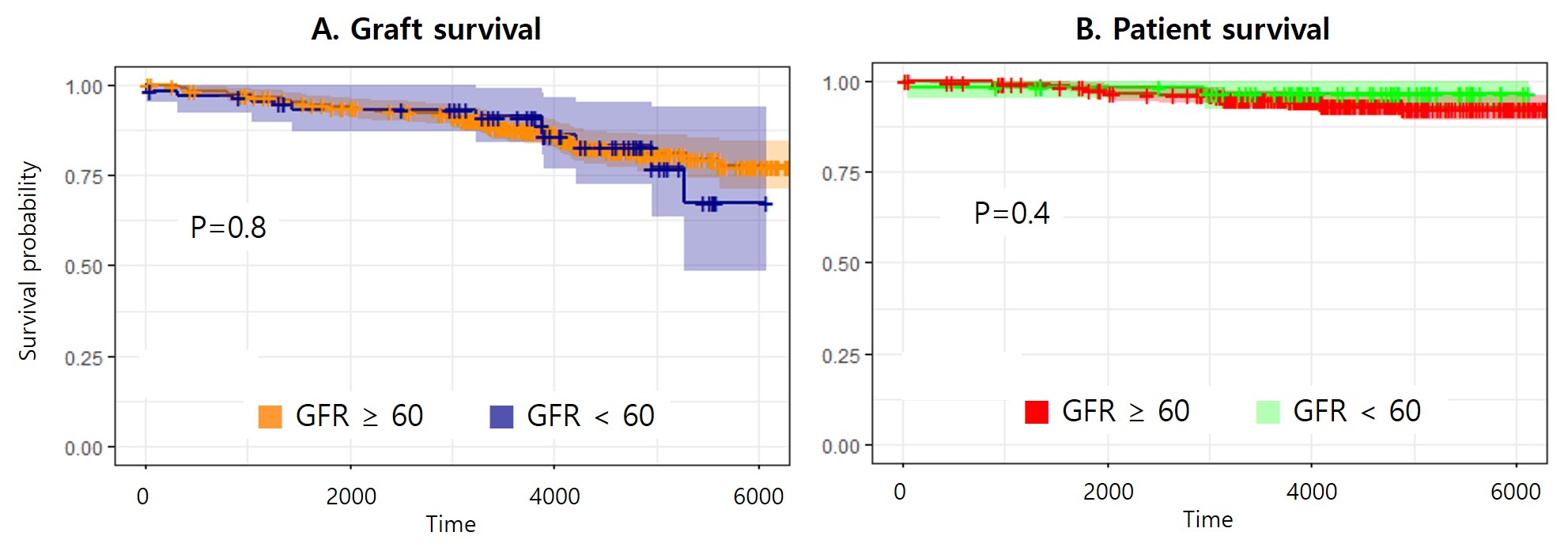The association of early graft function with long-term performance after standard-risk living-donor kidney transplantation
Mihyeong Kim1, Hyeongjin Cho1, Eunju Jang1, Kangwoong Jun1, Jeongkye Hwang1, Suncheol Park1, Jiil Kim2, Sangseop Yoon1.
1Surgery, Catholic University of Korea, Seoul, Korea; 2Surgery, Eulji hospital, Uljeongbu, Korea
Introduction After immunologically standard-risk kidney transplantation, graft function is often not recovered to normal levels. We tried to find out what causes the insufficiency recovery of graft function and how it affects in the long-term outcome.
Methods We analyzed the medical records of patient who received living-donor kidney transplantation (LDKT) between January 2006 and February 2014 in single institute. We excluded the immunologically high-risk transplantation; crossmatch positive, ABO type incompatible, PRA > 50% or multiple organ transplantation. Patient also was excluded who still on dialysis or rejection treatment at 1month. We divided patients into two groups according the highest glomerular filtration rate (GFR) within 1 month after transplant; GFR was 60 or more was defined as ‘standard group’ and less than 60 was defined as ‘suboptimal group’.
Results Total 411 patients were analyzed and mean period of follow-up 11.3 years. Sixty-one patients (14.8%) were in suboptimal group.(Table 1) In suboptimal group, there were more male recipients, high Body mass index, more diabetes patients. There were more female (not significant) and older donor in suboptimal group. In donor relationship graft donation from parents or spouse were more common than standard group. We further analyzed about size mismatch between donor (graft) and recipients, graft weight was lower and donation from female to male was more common in suboptimal group. In long-term outcome analysis, there was no significance in graft survival and patient survival.(Figure 1)
Conclusion In immunologically standard-risk LDKT, suboptimal graft function does not affect long-term outcome.
|
Standard outcome (n=350) |
Suboptimal outcome (n=61) |
p-value | |
| Male | 208 (59.4%) | 47 (77.0%) | 0.013 |
| BMI | 22.7 ± 3.4 | 24.7 ± 3.9 | <0.001 |
| DM | 75 (21.4%) | 22 (36.1%) | 0.02 |
| Donor age | 40.4 ± 11.0 | 47.5 ± 9.4 | <0.001 |
| Donor - male | 150 (42.9%) | 20 (32.8%) | 0.183 |
| Donor BMI | 23.8 ± 3.4 | 23.6 ± 3.0 | 0.731 |
| Donor relationship | 0.001 | ||
| Parents | 45 (12.9%) | 12 (19.7%) | |
| Offsprings | 67 (19.1%) | 4 (6.6%) | |
| Siblings | 128 (36.6%) | 15 (24.6%) | |
| Spouse | 74 (21.1%) | 22 (36.1%) | |
| Non-related | 19 (5.45%) | 8 (13.1%) | |
| Distant family | 17 (4.95%) | 0 | |
| Graft weight | 189.3 ± 34.4 | 168.2 ± 32.7 | <0.001 |
| Female to male KT | 124 (35.4%) | 35 (57.4%) | 0.002 |

[1] Kidney transplantation
[2] Graft survival
[3] donor selection
